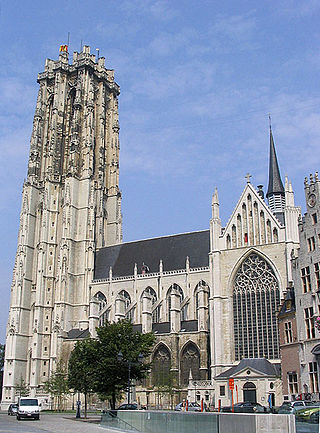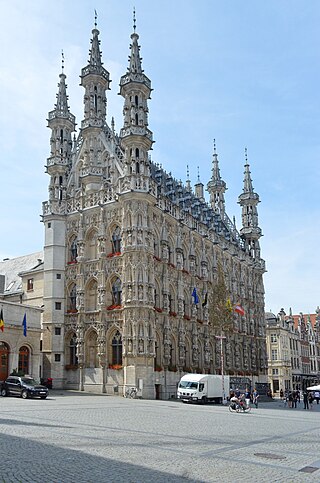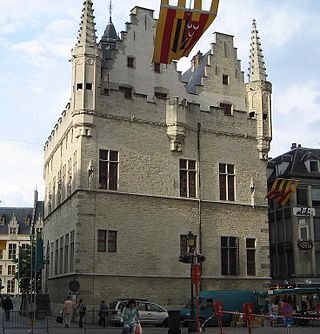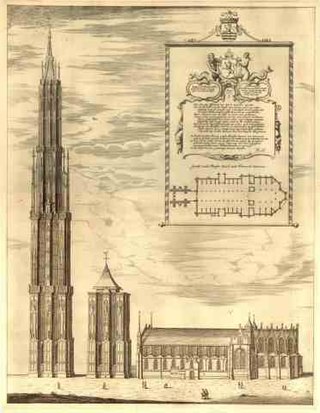Related Research Articles

St. Rumbold's Cathedral is the Roman Catholic metropolitan archiepiscopal cathedral in Mechelen, Belgium, dedicated to Saint Rumbold, Christian missionary and martyr who founded an abbey nearby. His remains are rumoured to be buried inside the cathedral. State-of-the-art examination of the relics honoured as Saint Rumbold's and kept in a shrine in the retro-choir, showed a life span of about 40 years and a death date between 580 and 655, while tradition had claimed 775 AD.

The Cathedral of St. Michael and St. Gudula, usually shortened to the Cathedral of St. Gudula or St. Gudula by locals, is a medieval Roman Catholic cathedral in central Brussels, Belgium. It is dedicated to Saint Michael and Saint Gudula, the patron saints of the City of Brussels, and is considered to be one of the finest examples of Brabantine Gothic architecture.

Matthias Vanden Gheyn was a Flemish musician from the Baroque/Classical transition period. He is a descendant of the famous bell founding family of the same name. During his life, Vanden Gheyn was considered an outstanding virtuoso of the carillon and organ. He is most famous for composing eleven preludes for carillon, which have become standard repertoire among carillonneurs worldwide since the early 1900s. His spot in history was earned in large part due to the tireless research of his biographer Xavier-Victor-Fidèle van Elewyck, a law and music scholar who considered Vanden Gheyn to be the greatest musician of the Southern Netherlands in the 18th century.

St. James' Church is a former collegiate church in Antwerp, Belgium. The church is built on the site of a hostel for pilgrims to Santiago de Compostela. The present building is the work of the Waghemakere family and Rombout Keldermans, in Brabantine Gothic style. The church contains the grave of Peter Paul Rubens in the eastern chapel.
Rombout II Keldermans, was an important architect from the Gothic period, born from a family of architects and sculptors.

The Town Hall of Leuven, Flemish Brabant, Belgium, is a landmark building on that city's Grote Markt, across from the monumental St. Peter's Church. Built in a Brabantine late-Gothic style between 1439 and 1469, it is famous for its ornate architecture, crafted in lace-like detail.
Rombout is a Dutch masculine given name, equivalent to English Rumbold. It is of Germanic origin, containing the Old Saxon elements -hrôm- and -bald- ("brave"). It is also possible that the first element comes from -Rûma- ("Rome"), a place name that also featured in old Germanic names. Early source usually Latinized Saint Rombout's name as Rumoldus, as in the first known mention in a pre-927 grant by Charles the Simple, mentioning that the Mechelen abbey had been built in his honor.

Saint Peter's Church in Leuven, Belgium, is a Roman Catholic church built in the 15th century in the Brabantine Gothic style. The church has a cruciform floor plan and a low bell tower that has never been completed. It is 93 metres (305 ft) long. It is located on the city's Grote Markt, opposite the Town Hall. In 1999, the belfry and bell tower of the church was inscribed on the UNESCO World Heritage List as part of the Belfries of Belgium and France site, in recognition of the civil importance and architecture of the belfries in the region.

Rombout Verhulst was a Flemish sculptor and draughtsman who spent most of his career in the Dutch Republic. An independent assistant of the Flemish sculptor Artus Quellinus the Elder in the sculptural decoration project for the new town hall in Amsterdam, he contributed to the spread of the Baroque style in Dutch sculpture. He became the leading sculptor of marble monuments, including funerary monuments, garden figures and portraits, in the Dutch Republic.

Jan Erasmus Quellinus was a Flemish painter and draughtsman and a member of the famous Quellinus family of artists. He was one of the last prominent representatives of the great Flemish school of history and portrait painting in the 17th century. His work displays the classicizing influences of his father Erasmus Quellinus the Younger and Paolo Veronese. Mainly active in his native Antwerp, he worked for some time in Vienna for the Habsburg court as a court painter to Emperor Leopold I.

From the 15th century onwards, the Great Council of the Netherlands at Mechelen was the highest court in the Burgundian Netherlands. It was responsible for the Dutch-, French- and German-speaking areas. In Luxembourgish the phrase "mir ginn op Mechelen" still means playing one's last trump card. The Grote Raad first sat in the Schepenhuis in Mechelen then, from 1616, in the (old) palace of Margaretha of Austria on Keizerstraat.

The Hof van Savoye or Palace of Margaret of Austria is an early 16th-century building in Mechelen, Belgium. It was one of the first Renaissance buildings in Northern Europe.

Brabantine Gothic, occasionally called Brabantian Gothic, is a significant variant of Gothic architecture that is typical for the Low Countries. It surfaced in the first half of the 14th century at St. Rumbold's Cathedral in the city of Mechelen.
Jean d'Oisy (1310–1377) was the architect of several ecclesiastical buildings in Brabantine Gothic style. He was one of the earliest introducers of northern French Gothic style into the Low Countries and a teacher of the reputed Brabantian architect Jacob van Thienen.

The Sint-Lievensmonstertoren, also known as the Dikke Toren is a 62 metre tall, unfinished, free standing church tower in Zierikzee, Netherlands. The accompanying church was destroyed by a fire in 1832.

Rombaut Pauwels or Rombout Pauwels was a Flemish architect and sculptor who worked in a moderate Baroque style. Rombaut Pauwels was active mainly in his hometown Mechelen and in Ghent.
Jan van Mansdale, also Jan I Keldermans was a Brussels sculptor. He is considered the ancestor of the Keldermans family from Mechelen, which produced many master builders and sculptors.

Ghent City Hall is a four-sided complex in Ghent, East Flanders, Belgium, surrounded by the Botermarkt, the Hoogpoort, the Stadhuissteeg and the Poeljemarkt. The main wings are the late-Gothic alderman's house of De Keure and the alderman's house of Gedele in the Renaissance style. The building has 51 halls.
Domien de Waghemakere, or Dominikus, was a Flemish architect and an important exponent of Brabantine Gothic.

St. Catherine's Church in Hoogstraten, Belgium, was built between 1525 and 1550 by order of Antoon van Lalaing and Elisabeth van Culemborg, Count and Countess of the County of Hoogstraten. The imposing building is also referred to as “Cathedral of the Kempen” or popularly as “our Katrien”.
References
- ↑ "Wie ontwierp de Sint - Romboutstoren in Mechelen?". 2009-08-15. Archived from the original on 2009-08-15. Retrieved 2023-07-21.
- "Keldermans". Winkler Prins encyclopedia (8 ed.). 1975.